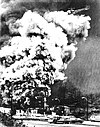Related Research Articles
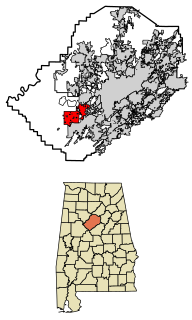
Hueytown is a city near Bessemer in western Jefferson County, Alabama, United States. It is part of the Birmingham metropolitan area, and was part of the heavy industry development in this area in the 20th century. At the 2010 census, the population was 16,105.
A mining accident is an accident that occurs during the process of mining minerals or metals. Thousands of miners die from mining accidents each year, especially from underground coal mining, although accidents also occur in hard rock mining. Coal mining is considered much more hazardous than hard rock mining due to flat-lying rock strata, generally incompetent rock, the presence of methane gas, and coal dust. Most of the deaths these days occur in developing countries, and rural parts of developed countries where safety measures are not practiced as fully.

The Farmington Mine disaster was an explosion that happened at approximately 5:30 a.m. on November 20, 1968, at the Consol No. 9 coal mine north of Farmington and Mannington, West Virginia, United States.
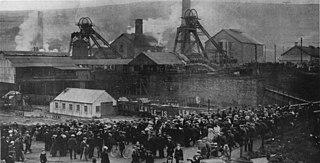
The Senghenydd colliery disaster, also known as the Senghenydd explosion, occurred at the Universal Colliery in Senghenydd, near Caerphilly, Glamorgan, Wales, on 14 October 1913. The explosion, which killed 439 miners and a rescuer, is the worst mining accident in the United Kingdom. Universal Colliery, on the South Wales Coalfield, extracted steam coal, which was much in demand. Some of the region's coal seams contained high quantities of firedamp, a highly explosive gas consisting of methane and hydrogen.

The Oaks Colliery explosion was a British mining disaster which occurred on 12 December 1866, killing 361 miners and rescuers at the Oaks Colliery at Hoyle Mill near Stairfoot in Barnsley, West Riding of Yorkshire. The disaster centred upon a series of explosions caused by firedamp, which ripped through the underground workings. It is the worst mining accident in England and the second worst mining disaster in the United Kingdom, after the Senghenydd colliery disaster in Wales.
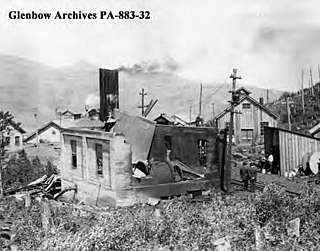
The Hillcrest mine disaster, the worst coal mining disaster in Canadian history, occurred at Hillcrest, Alberta, in the Crowsnest Pass region of western Canada, on Friday, June 19, 1914, 9:30 am.

Mining in Australia has long been a significant primary sector industry and contributor to the Australian economy by providing export income, royalty payments and employment. Historically, mining booms have also encouraged population growth via immigration to Australia, particularly the gold rushes of the 1850s. Many different ores, gems and minerals have been mined in the past and a wide variety are still mined throughout the country.
The Moweaqua Coal Mine Disaster happened on December 24, 1932, in Moweaqua, Illinois. The disaster was caused by a methane gas explosion killing 54 miners. The explosion occurred shortly after the day shift started, sometime between 7:30 and 8:00 Christmas Eve morning.
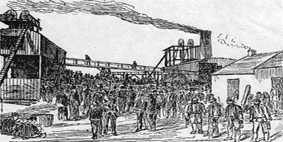
The Udston mining disaster occurred in Hamilton, Scotland on Saturday, 28 May 1887 when 73 miners died in a firedamp explosion at Udston Colliery. Caused, it is thought, by unauthorised shot firing the explosion is said to be Scotland's second worst coal mining disaster.
The Castle Gate mine disaster occurred on March 8, 1924, in a coal mine near the town of Castle Gate, Utah, located approximately 90 miles southeast of Salt Lake City. All of the 171 men working in the mine were killed in the series of three violent explosions. One worker, the leader of the rescue crew, died from carbon monoxide inhalation while attempting to reach the victims shortly after the explosion.

The Darr Mine disaster at Van Meter, Rostraver Township, Westmoreland County, Pennsylvania, near Smithton, killed 239 men and boys on December 19, 1907. It ranks as the worst coal mining disaster in Pennsylvanian history.
The 1965 Dhanbad coal mine disaster occurred on 28 May 1965, in a coal mine near Dhanbad, a town in India. On the fateful day, there was an explosion in Dhori colliery near Dhanbad, which led to fire in the mines. The fire killed 268 miners. Dhori colliery is located near Bermo. The mine was at that time privately owned by the Raja of Ramgarh

The Drummond Mine explosion, also called the Drummond Colliery Disaster, was a mining accident that happened in Westville, Pictou County, Nova Scotia on May 13, 1873.
The Scofield Mine disaster was a mining explosion that occurred at the Winter Quarters coal mine on May 1, 1900. The mine was located at 39°42′57″N111°11′17″W near the town of Scofield, Utah. In terms of life lost it was the worst mining accident at that point in American history. The explosion is also a key element in the plot of the Carla Kelly novel My Loving Vigil Keeping.
The Cadeby Main Pit Disaster was a coal mining accident on 9 July 1912 at Cadeby Main Colliery at Cadeby, at Doncaster, now in South Yorkshire, England, killing 87 men. Early in the morning of 9 July 1912 an explosion in the south-west part of the Cadeby Main pit killed 35 men with 3 more dying later due to their injuries. Later in the same day after a rescue party was sent below ground another explosion took place killing 53 men of the rescue party.
The Collinsville mine disaster on 13 October 1954 resulted in the death of seven men at the Collinsville coal mine in Collinsville, Queensland, Australia.

The Coal Mines Act 1911 amended and consolidated legislation in the United Kingdom related to collieries. A series of mine disasters in the 19th and early-20th centuries had led to commissions of enquiry and legislation to improve mining safety. The 1911 Act, sponsored by Winston Churchill, was passed by the Liberal government of H. H. Asquith. It built on earlier regulations and provided for many improvement to safety and other aspects of the coal mining industry. An important aspect was that mine owners were required to ensure there were mines rescue stations near each colliery with equipped and trained staff. Although amended several times, it was the main legislation governing coal mining for many years.

The Lundhill Colliery explosion was a coal mining accident which took place on 19 February 1857 in Wombwell, Yorkshire, UK in which 189 men and boys aged between 10 and 59 died. It is one of the biggest industrial disasters in the country's history and it was caused by a firedamp explosion. It was the first disaster to appear on the front page of the London Illustrated Times.
Hapton Valley Colliery was a coal mine on the edge of Hapton near Burnley in Lancashire, England. Its first shafts were sunk in the early 1850s and it had a life of almost 130 years, surviving to be the last deep mine operating on the Burnley Coalfield.
References
- ↑ "Coal Mining Disasters: 1839 to Present". Center for Disease Control and Prevention. Retrieved 15 July 2016.
- ↑ Jones, Adam (8 April 2011). "State's larger mining accident claimed 128 men 100 years ago". Tuscaloosa News. Retrieved 1 October 2016.
- ↑ Flynt, Wayne (February 5, 2016). Poor But Proud. 2990: University of Alabama Press.CS1 maint: location (link)
- ↑ Ward, Robert David. "Banner Mine Tragedy of 1911". Encyclopedia of Alabama. Retrieved 1 October 2016.
Coordinates: 33°41′19″N86°59′54″W / 33.688714°N 86.998225°W
